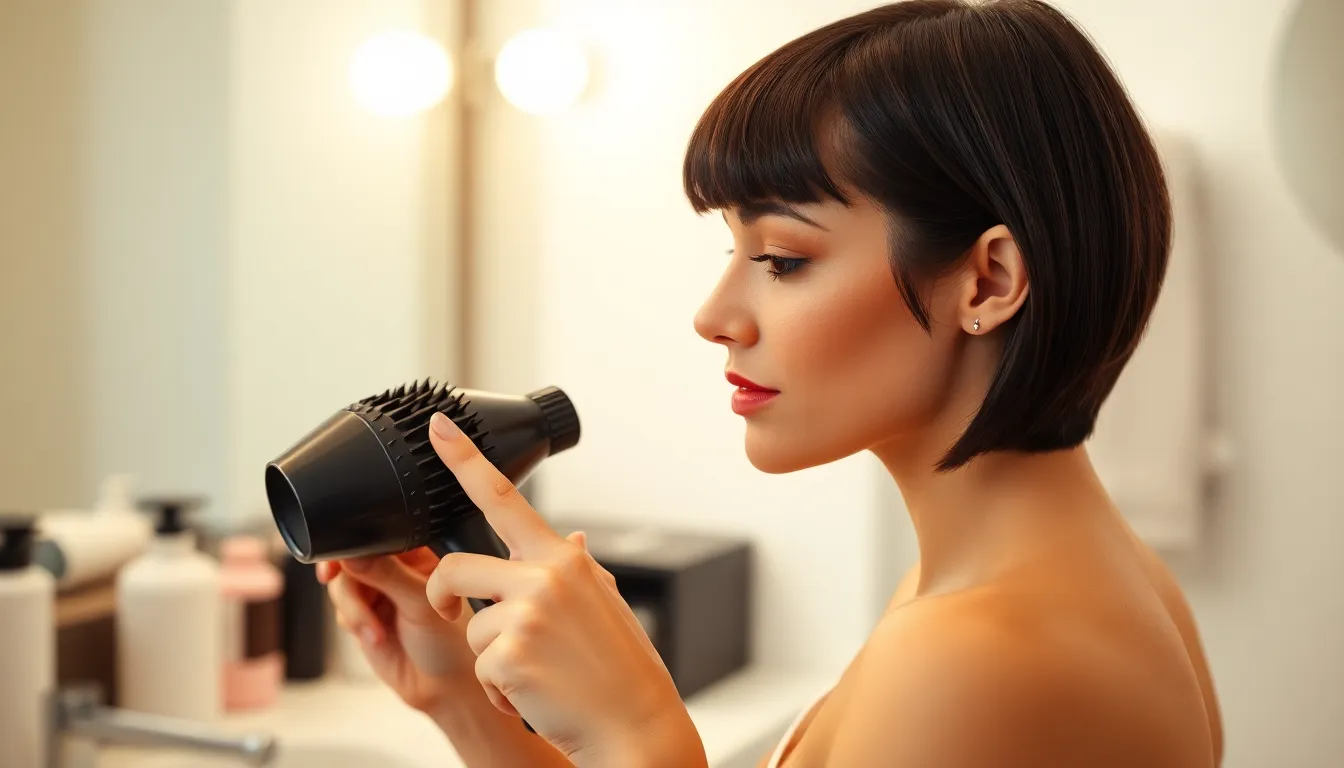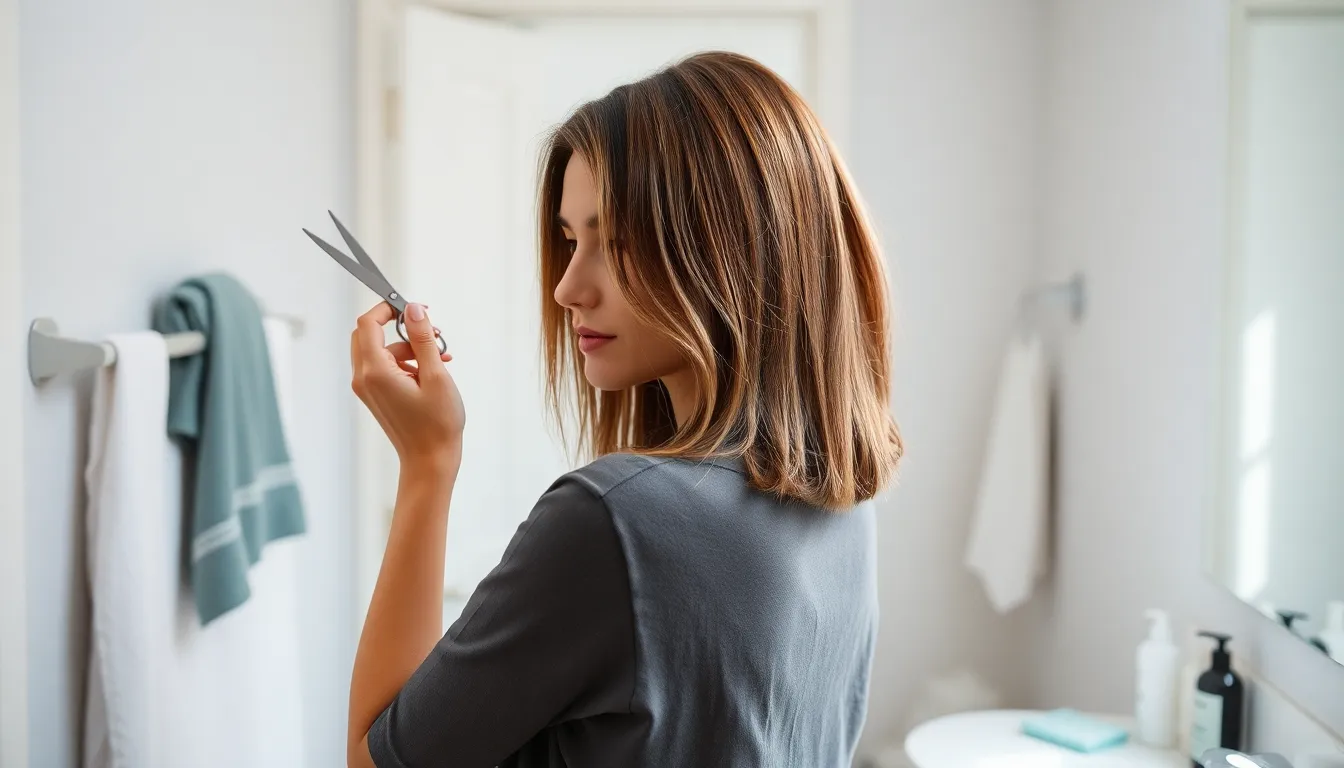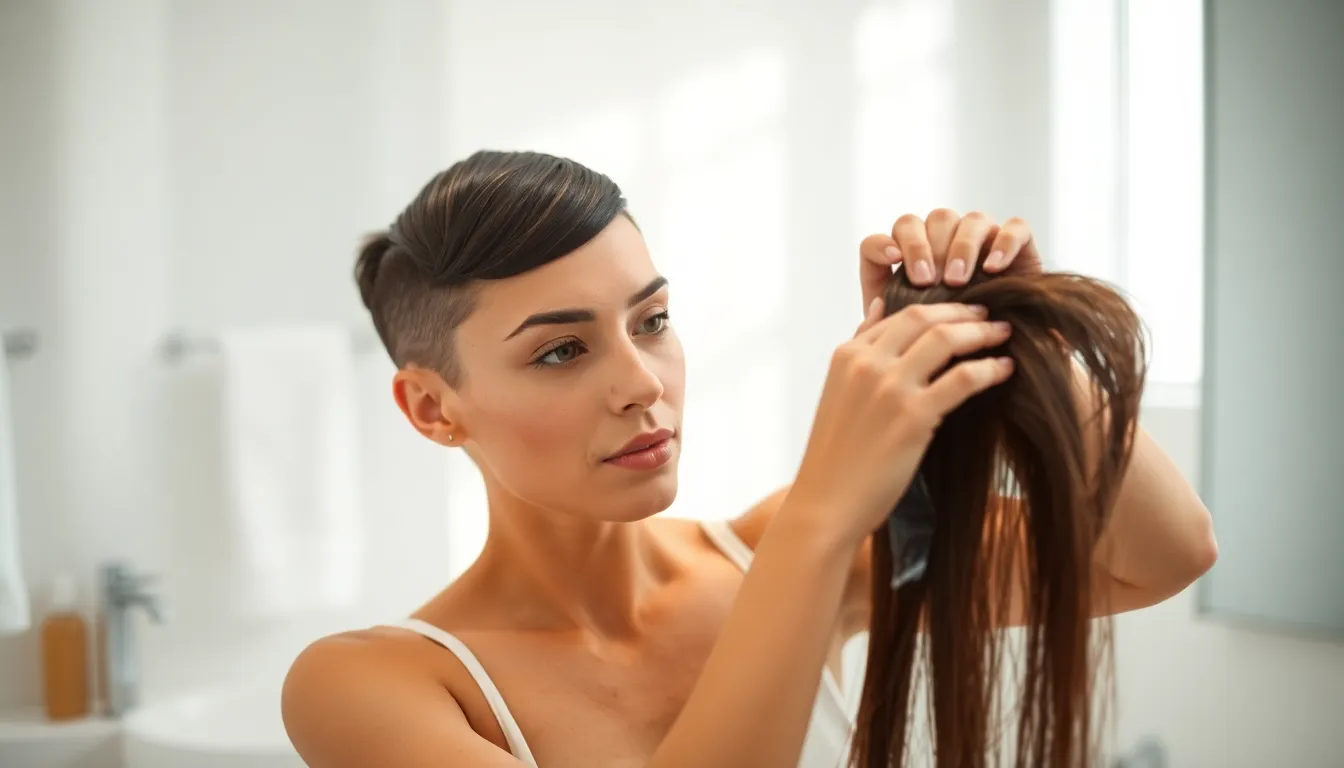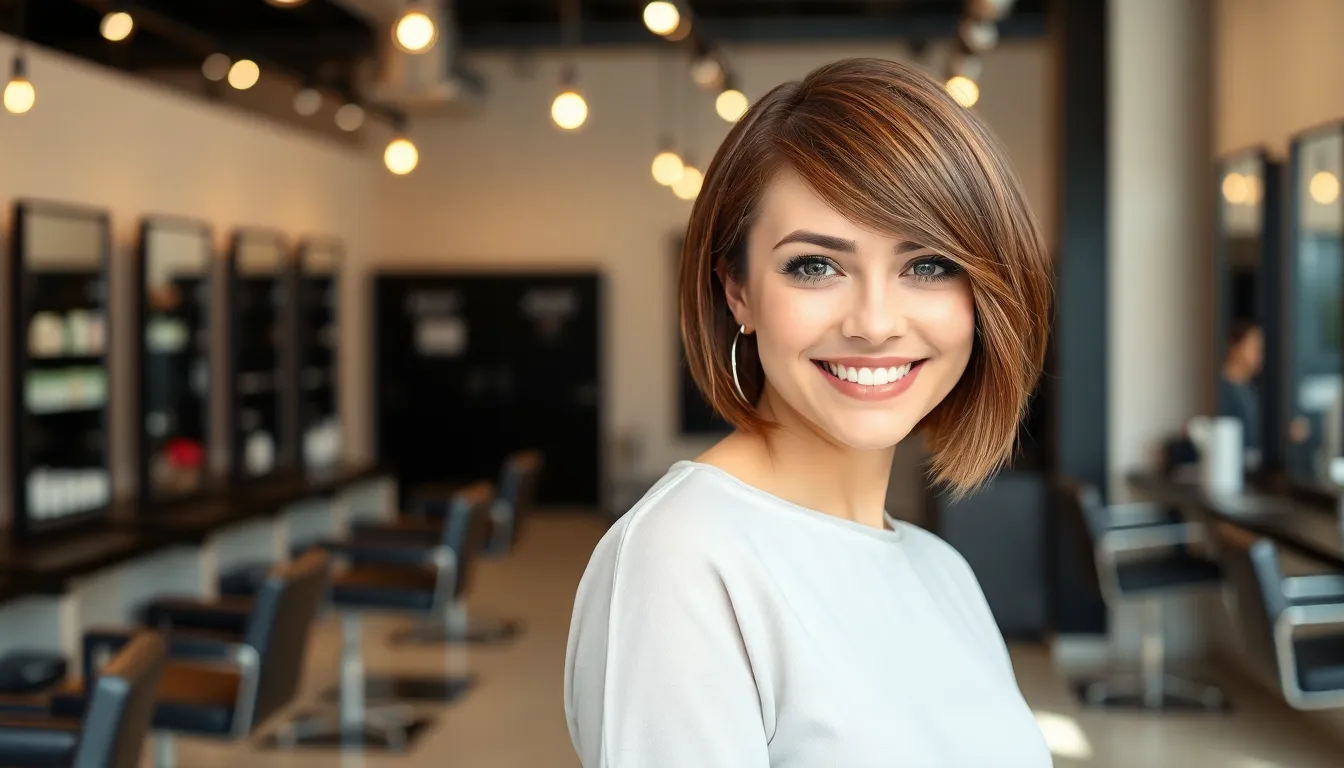The pageboy haircut has made a stunning comeback in recent years and we can’t get enough of this timeless style that perfectly balances vintage charm with modern sophistication. This classic cut that dominated the fashion scene in the 1920s and 1960s is now capturing hearts once again with its sleek blunt edges and elegant inward curve that frames the face beautifully.
We’ve watched countless celebrities and fashion influencers embrace the pageboy’s versatility from chin-length bobs to shoulder-grazing variations. Whether you’re looking for a dramatic hair transformation or simply want to refresh your current look this iconic cut offers endless styling possibilities that work with virtually any hair texture.
What makes the pageboy truly special is its ability to create an instantly polished appearance while remaining surprisingly low-maintenance. We’re here to guide you through everything you need to know about this trendy haircut from styling techniques to maintenance tips that’ll keep your pageboy looking salon-fresh every day.
What Is a Pageboy Haircut and Why It’s Making a Comeback
Defining the pageboy haircut requires understanding its signature curved silhouette. This classic style features hair that’s cut in a straight line around the head, typically at chin or shoulder length, with ends that curl under toward the neck. The distinctive inward curve creates a polished, sophisticated look that frames the face beautifully.
Tracing the pageboy’s origins takes us back to medieval times. Young male pages in royal courts wore their hair in this distinctive style, which later transitioned into women’s fashion during the early 20th century. We saw the haircut reach peak popularity in the 1920s when Louise Brooks made it iconic, then again in the 1960s when celebrities like Mia Farrow brought it back into the spotlight.
Modern interpretations of the pageboy are driving its current resurgence. Today’s stylists are adapting the classic cut with contemporary touches like textured layers, asymmetrical lengths, and subtle highlights. We’re seeing variations that work with natural hair textures rather than requiring extensive heat styling, making it more accessible than ever before.
Several factors are fueling the pageboy’s comeback in 2025. The rise of vintage aesthetics on social media platforms has sparked renewed interest in retro hairstyles. Also, the shift toward low maintenance beauty routines has made this naturally polished cut appealing to busy professionals and style conscious individuals alike.
Celebrity endorsements are amplifying the pageboy’s popularity. Stars like Emma Stone, Taylor Swift, and Zendaya have been spotted wearing modern versions of this timeless cut on red carpets and in everyday settings. Their influence has inspired countless fans to embrace the pageboy’s effortless elegance.
The pageboy’s versatility makes it suitable for various occasions. Whether you’re heading to a business meeting or a casual brunch, this haircut maintains its polished appearance throughout the day. We appreciate how it transitions seamlessly from professional settings to social events without requiring important restyling.
How to Choose the Right Pageboy Style for Your Face Shape

Selecting the perfect pageboy variation depends on understanding your unique facial structure and proportions. We’ll guide you through the best pageboy adaptations for each face shape to ensure your new haircut enhances your natural features.
Round Face Shape Considerations
Angular pageboy cuts work best for round faces by creating vertical lines that elongate your appearance. We recommend keeping the length at or below the chin to avoid adding width at the cheekbones. Side parts create asymmetry that breaks up the circular silhouette while adding visual interest.
Textured layers near the crown add height and volume to balance fuller cheeks. Stylists often incorporate subtle graduation throughout the cut to create movement without sacrificing the pageboy’s signature structure. Avoid blunt cuts that end at cheek level as they emphasize roundness.
Longer pageboy variations that graze the collarbone work exceptionally well for round faces. The extended length draws the eye downward while maintaining the classic inward curve. This creates a slimming effect that complements rounder facial features perfectly.
Square Face Shape Modifications
Softened pageboy edges minimize the appearance of strong jawlines while maintaining the style’s elegance. We suggest incorporating gentle layers around the face to create curves that counterbalance angular features. Wispy bangs or face framing pieces add femininity to the overall look.
Chin length pageboy cuts hit at the perfect spot to soften square jaw angles. The inward curve directs attention to the center of your face rather than the jaw corners. Stylists often add subtle texture to prevent the cut from appearing too geometric.
Asymmetrical pageboy styles break up the symmetry of square faces beautifully. One side can be slightly longer than the other creating visual interest and movement. This modern twist on the classic pageboy adds contemporary flair while flattering angular features.
Oval Face Shape Options
Traditional pageboy cuts suit oval faces exceptionally well since this face shape is considered the most versatile. You can experiment with various lengths from chin to shoulder without worrying about proportion issues. Classic blunt cuts with clean lines showcase the pageboy’s timeless appeal.
Experimental pageboy variations work wonderfully on oval faces including ultra short crops or longer shoulder grazing styles. We often recommend trying bold interpretations like asymmetrical lengths or dramatic side parts. Your balanced proportions can handle more adventurous pageboy styling.
Textured pageboy styles add dimension to oval faces without overwhelming your features. Subtle layers throughout create movement while maintaining the signature curve. This approach works particularly well for those with fine or straight hair textures.
Heart-Shaped Face Adaptations
Fuller pageboy bottoms balance narrow chins characteristic of heart shaped faces. We recommend keeping more weight and volume in the lower sections of the cut. The pageboy’s natural inward curve creates the illusion of width at the jawline.
Chin length pageboy cuts work perfectly for heart shaped faces by adding visual weight to the lower portion of your face. Avoid styles that are too short as they can emphasize the width of your forehead. The classic pageboy length hits at the ideal spot for balancing proportions.
Side swept bangs complement pageboy cuts on heart shaped faces by minimizing forehead width. These softer bang styles blend seamlessly into the pageboy’s structure while creating a more proportioned appearance. Avoid heavy straight across bangs that can overwhelm delicate chin lines.
Essential Tools and Products for Achieving the Perfect Pageboy

Creating that signature pageboy curve requires the right arsenal of tools and products. Professional quality equipment makes the difference between a salon worthy finish and a homemade attempt.
Professional Styling Tools
Round brush with ceramic barrel serves as your primary weapon for achieving the pageboy’s distinctive inward curl. We recommend a 2 inch barrel for shoulder length cuts and 1.5 inch for chin length styles. Ceramic technology distributes heat evenly while reducing frizz and static.
High quality blow dryer with ionic technology speeds up styling time while protecting your hair from heat damage. Look for models with multiple heat settings and a cool shot button to lock in your pageboy’s shape. Professional grade dryers like Dyson or BaByliss deliver salon results at home.
Flat iron with adjustable temperature control helps perfect those sleek blunt edges that define the pageboy haircut. Choose titanium or ceramic plates for smooth gliding and consistent heat distribution. We suggest keeping temperatures between 300-350°F for fine hair and 350-400°F for thick or coarse textures.
Wide tooth comb and rat tail comb become essential for sectioning and detangling during the styling process. The wide tooth version prevents breakage on wet hair while the rat tail creates precise parts and separates sections during blow drying.
Must-Have Hair Products
Heat protectant spray forms your first line of defense against styling damage while maintaining the pageboy’s sleek appearance. Apply this product to damp hair before any heat styling to preserve moisture and prevent split ends. Quality formulas like Redken Iron Shape 11 or Tresemme Thermal Creations offer superior protection.
Volumizing mousse adds body and lift at the roots without weighing down your pageboy’s delicate shape. We recommend applying a golf ball sized amount to damp hair focusing on the crown area. This creates the necessary foundation for that perfect curved silhouette.
Smoothing serum or oil tames flyaways and adds shine to complete your polished pageboy look. Use sparingly on the mid lengths and ends to avoid greasy roots. Argan oil based products work exceptionally well for this haircut style.
Strong hold hairspray locks your pageboy curve in place throughout the day. Choose flexible hold formulas that maintain movement while preventing humidity induced frizz. Professional brands like Sebastian Shaper or Kenra Volume Spray deliver lasting results.
Maintenance Accessories
Silk or satin pillowcases preserve your pageboy’s shape while you sleep by reducing friction and preventing bedhead. These materials help maintain moisture levels and minimize tangles that could disrupt your carefully crafted style.
Microfiber hair towel gently removes excess water without causing frizz or breakage. Traditional terry cloth towels can roughen the hair cuticle and destroy the smooth finish essential to the pageboy haircut. Wrap your hair gently rather than vigorously rubbing.
Hair clips and sectioning tools organize your hair during styling sessions and touch ups. Invest in both small duck bill clips for precise sectioning and larger clips to hold styled sections out of the way. These tools ensure even heat distribution and professional looking results.
Travel sized products maintain your pageboy’s appearance when you’re away from home. Pack miniature versions of your essential styling products including heat protectant, serum, and hairspray. This preparation ensures your pageboy looks salon fresh regardless of location.
Step-by-Step Guide to Cutting a Classic Pageboy at Home

Cutting your own pageboy haircut requires precision and patience to achieve that signature curved silhouette. We’ll walk you through the essential techniques professionals use to create this timeless style from the comfort of your home.
Preparing Your Hair for the Cut
Start with freshly washed hair using a clarifying shampoo to remove any product buildup that might interfere with accurate cutting. Towel dry gently with a microfiber towel to minimize frizz and damage before beginning the cutting process.
Section your hair into four quadrants by creating a part from ear to ear across the crown and another from forehead to nape. Secure each section with professional clips to maintain clean divisions throughout the cutting process.
Comb through each section thoroughly using a wide tooth comb to eliminate any tangles or knots. Work from ends to roots to prevent unnecessary breakage and ensure smooth cutting lines.
Apply a light leave in conditioner to damp hair for easier manipulation and cleaner cuts. This step helps the scissors glide smoothly through your hair while protecting against damage during the cutting process.
Creating the Foundation Length
Measure your desired length by holding your hair straight down and marking the cutting point with your fingers. Most pageboy cuts fall between chin and shoulder length for that classic proportioned look.
Cut the back section first by taking horizontal sections starting from the nape and working upward. Keep your scissors parallel to the floor and cut straight across to establish your base length.
Move to the side sections by pulling hair straight down from each ear and cutting to match your established back length. Check both sides frequently to ensure symmetry and adjust as needed.
Test your foundation by combing all sections straight down and examining the hemline in a mirror. The cut should form an even line around your head when hair hangs naturally.
Refine any uneven spots by taking small sections and point cutting slightly upward into the hair. This technique softens harsh lines while maintaining the blunt edge characteristic of pageboy cuts.
Shaping the Signature Curved Ends
Begin the undercut technique by holding horizontal sections of hair at a 45 degree angle and cutting upward into the ends. This creates the internal layering that allows hair to curve under naturally.
Work systematically around your head starting from one ear and moving to the other, maintaining consistent angles and pressure. Each section should be slightly shorter than the one below it to create that signature inward curve.
Use point cutting motions to add texture and movement to the ends while preserving the overall blunt appearance. Cut into the hair at various depths to create natural looking variation in the edge line.
Check the curve formation by blow drying sections with a round brush, rolling hair under as you dry. The ends should naturally want to curl inward without forcing them into position.
Refine the face framing pieces by cutting them slightly shorter than the rest to enhance the pageboy’s flattering silhouette. These pieces should gracefully curve toward your jawline to complete the classic look.
Blend any disconnected areas using thinning shears or point cutting techniques to ensure smooth transitions between sections. The final result should show a seamless curve that follows your head’s natural shape.
Modern Variations of the Traditional Pageboy Haircut

We’ve discovered that contemporary stylists are reimagining the classic pageboy with fresh interpretations that cater to today’s diverse style preferences. These modern variations maintain the haircut’s signature curved silhouette while incorporating current trends and textures.
The Asymmetrical Pageboy
Asymmetrical pageboys break traditional symmetry rules by featuring uneven lengths that create ever-changing visual interest. One side typically extends longer than the other, often reaching the shoulder while the opposite side sits at jaw length. Stylists achieve this edgy variation by creating diagonal cutting lines that gradually transition from shorter to longer sections.
We recommend this variation for clients seeking a contemporary twist on the classic style. The asymmetrical approach works exceptionally well for oval and heart shaped faces, as the uneven lengths add movement and soften facial features. Celebrities like Rihanna and Victoria Beckham have popularized this modern interpretation, showcasing its versatility across different hair textures.
Styling requires minimal effort since the cut’s structure creates natural movement. A lightweight smoothing serum enhances the curved ends while maintaining the sharp contrast between the longer and shorter sections.
The Textured Pageboy
Textured pageboys incorporate layered cutting techniques that add dimension and movement to the traditional blunt edges. Stylists use point cutting and razor techniques to create subtle variations in length throughout the hair, resulting in a softer, more lived in appearance. These layers work particularly well for naturally wavy or curly hair textures.
We find this variation appeals to clients who want the pageboy’s polished look without the severity of completely blunt cuts. The added texture reduces styling time since the layers naturally enhance the hair’s movement and volume. Emma Stone frequently wears this variation, demonstrating how textured pageboys complement both casual and formal occasions.
Maintenance involves using texturizing products like sea salt spray or light mousse to enhance the natural movement. The textured approach allows for more flexible styling options while preserving the pageboy’s essential curved silhouette.
The Long Pageboy Bob
Long pageboy bobs extend the traditional length to reach the collarbone or shoulder area, creating an elegant and sophisticated silhouette. This variation maintains the classic inward curl at the ends while providing more versatility for styling options. The extended length works beautifully with both straight and slightly wavy hair textures.
We’ve noticed this variation particularly suits professional environments where longer hair is preferred. The length allows for easy updo styling while maintaining the pageboy’s signature curved ends when worn down. Taylor Swift has been spotted wearing this variation, proving its adaptability for both red carpet and everyday styling.
Styling typically requires a larger barrel brush to create the gentle inward curve at the extended length. The longer sections provide more weight, which helps maintain the smooth, polished appearance characteristic of pageboy cuts.
The Micro Pageboy
Micro pageboys feature dramatically shortened lengths that typically end above the ears, creating a bold and modern statement. This variation emphasizes the pageboy’s curved silhouette in a concentrated form, requiring precise cutting techniques to achieve the perfect proportions. The shorter length highlights facial features and jawline definition.
We suggest this variation for clients with strong facial bone structure who want to make a confident style statement. The micro length works exceptionally well for fine hair textures, as the shortened weight creates natural volume and body. Fashion forward celebrities like Charlize Theron have embraced this daring interpretation.
Styling becomes incredibly low maintenance with the micro pageboy since the shorter length holds its shape naturally. A small amount of smoothing cream and quick blow dry with a round brush maintains the signature inward curve throughout the day.
Celebrity Inspiration: Stars Who Rock the Pageboy Look

We’ve seen countless celebrities embrace the pageboy haircut, proving its enduring appeal across generations and red carpet events. Taylor Swift showcased a stunning chin-length pageboy during her 2014 era, demonstrating how the style creates elegant movement with every turn of the head. Emma Stone elevated the classic cut with subtle layers and a rich auburn color that perfectly complemented her facial structure.
Zendaya transformed her pageboy into a fashion statement by adding textured waves that maintained the signature inward curl while incorporating modern volume techniques. Anne Hathaway’s sleek interpretation featured razor-sharp edges and a deep side part that emphasized the haircut’s sophisticated silhouette. Charlize Theron opted for a platinum blonde version that highlighted the pageboy’s clean lines and geometric precision.
We’ve observed how Jennifer Lawrence styled her pageboy with effortless waves, creating a more relaxed interpretation that still honored the classic framework. Reese Witherspoon’s golden pageboy became iconic during award season, featuring perfectly polished ends that curved naturally under her jawline. Scarlett Johansson experimented with an asymmetrical pageboy that added contemporary edge while preserving the timeless appeal.
Modern influencers like Alexa Chung have reinvented the pageboy with choppy layers and lived-in texture that appeals to younger audiences seeking vintage-inspired looks. We’ve noticed how these celebrities adapt the pageboy to their personal style preferences, whether through subtle color variations, different parting techniques, or unique styling approaches.
Each star demonstrates the pageboy’s versatility across different hair textures and face shapes, inspiring countless fans to request similar cuts at their local salons. Their red carpet appearances consistently showcase how the pageboy transitions seamlessly from casual daywear to formal evening events.
Daily Styling Techniques for Your Pageboy Haircut

Mastering your pageboy’s daily styling routine ensures you maintain that signature curved silhouette while adapting to different occasions. We’ll explore three essential techniques that keep your pageboy looking fresh and polished every day.
Creating Volume and Movement
Start with damp hair and apply volumizing mousse from roots to mid-lengths for maximum lift. We recommend using a round ceramic brush to lift sections at the crown while blow-drying upward and away from your face.
Flip your head upside down during the final blow-dry stage to encourage natural volume at the roots. This technique works particularly well for fine hair textures that tend to fall flat throughout the day.
Use a flat iron to create subtle bends at the roots, gently lifting small sections and creating an “S” curve motion. We suggest working in 1-inch sections to ensure even distribution of volume without disrupting the pageboy’s signature inward curve.
Finish with texturizing spray applied to the crown area while scrunching gently with your fingers. This adds grip and maintains the lifted effect throughout your busy day.
Sleek and Polished Styling
Begin with smoothing serum applied to towel-dried hair, focusing on the mid-lengths and ends to eliminate frizz. We always distribute product evenly using a wide-tooth comb to prevent buildup.
Blow-dry with a paddle brush using downward strokes to create that mirror-like finish characteristic of classic pageboy styling. Keep the dryer nozzle pointing down the hair shaft to seal the cuticles and enhance shine.
Run a flat iron through small sections from roots to ends, curling the tool slightly inward at the bottom to maintain the signature pageboy curve. We recommend using a temperature between 300-350°F to protect your hair while achieving lasting smoothness.
Lock in the style with a light mist of anti-humidity hairspray, holding the bottle 8-10 inches away from your head. This prevents weather-related frizz while maintaining the sleek appearance for up to 12 hours.
Adding Waves and Texture
Create soft waves using a 1.5-inch curling iron, wrapping sections away from your face and leaving the ends out for a modern twist. We curl each section for 8-10 seconds to achieve natural-looking movement without compromising the pageboy’s structure.
Use sea salt spray on damp hair before diffusing with a blow dryer to enhance your hair’s natural texture. This technique works especially well for those with naturally wavy hair who want to embrace their texture within the pageboy framework.
Scrunch texturizing cream through the mid-lengths and ends while your hair is still slightly damp, then air dry for effortless beachy waves. We find this method creates the perfect balance between the pageboy’s polished edges and relaxed texture.
Finish with flexible hold hairspray applied while scrunching sections upward to maintain the wave pattern. This ensures your textured pageboy maintains its shape while allowing natural movement throughout the day.
Common Mistakes to Avoid When Getting a Pageboy

Choosing the wrong length represents one of the most frequent pageboy mistakes we see in salons today. Many clients request a length that doesn’t complement their face shape or lifestyle, resulting in a cut that requires constant styling adjustments. We recommend discussing your daily routine with your stylist before committing to a exact length, as shorter pageboys demand more frequent touch-ups while longer versions may lose their signature curved silhouette.
Skipping the consultation process leads to disappointing results that could have been easily avoided. Stylists need to assess your hair texture, natural growth patterns, and face shape to create a pageboy that works specifically for you. We’ve found that clients who bring reference photos and discuss their styling preferences during consultation receive cuts that better match their expectations and maintenance capabilities.
Ignoring your hair’s natural texture creates ongoing styling challenges that make the pageboy difficult to maintain. Fine hair requires different cutting techniques than thick or coarse hair to achieve the proper volume and curve. We suggest working with your natural texture rather than fighting against it, as this approach ensures your pageboy looks effortless and stays true to its classic shape between salon visits.
Requesting dramatic changes too quickly often results in cuts that feel unfamiliar and difficult to style. Transitioning from long hair to a pageboy works best when done gradually, allowing you to adjust to shorter lengths and new styling routines. We recommend starting with a longer pageboy variation and gradually shortening it during subsequent appointments until you find your ideal length.
Neglecting to discuss styling time with your stylist can lead to frustration when you realize your new pageboy requires more daily maintenance than anticipated. Different pageboy variations demand varying amounts of styling time and skill level. We advise being honest about your morning routine and styling abilities so your stylist can recommend a version that fits your lifestyle.
Choosing an inexperienced stylist for precision cuts like the pageboy often produces uneven results that compromise the style’s signature symmetry. This classic cut requires exact technical skills to achieve clean lines and proper curves. We recommend researching stylists who specialize in vintage inspired cuts and have portfolio examples of successful pageboy transformations.
Overlooking maintenance requirements leaves many clients unprepared for the regular trims needed to keep their pageboy looking sharp. This style grows out differently than layered cuts and requires touch-ups every 4-6 weeks to maintain its shape. We suggest budgeting for regular salon visits and discussing a maintenance schedule with your stylist before getting the cut.
Using inappropriate styling products can weigh down the pageboy’s natural bounce and interfere with its curved ends. Heavy oils and thick creams often make the hair look greasy and flat, while products with strong hold can create stiffness that contradicts the pageboy’s fluid movement. We recommend starting with lightweight formulas and gradually adjusting product amounts based on your hair’s response.
How to Maintain Your Pageboy Haircut Between Salon Visits

Keeping your pageboy haircut fresh between professional appointments requires consistent care and strategic touch ups. We’ll show you how to preserve that signature curved silhouette and sleek edges with simple weekly routines and safe trimming techniques.
Weekly Care Routine
Deep conditioning treatments should be your first priority every week to maintain the pageboy’s signature smoothness. Apply a moisturizing hair mask from mid length to ends, focusing on areas where the hair curves under. Leave the treatment on for 15-20 minutes before rinsing thoroughly with cool water.
Gentle brushing sessions using a boar bristle brush help distribute natural oils and maintain the pageboy’s curved shape. Start from the ends and work upward to prevent breakage. Brush your hair when it’s slightly damp to reduce friction and preserve the blunt edges.
Root touch ups with dry shampoo keep your pageboy looking fresh between washes. Spray the product 6 inches away from your scalp and massage with fingertips. Focus on the crown area where oil tends to accumulate first.
Heat protection application becomes essential during your weekly styling routine. Spray a thermal protectant throughout your hair before using any heated tools. This prevents damage to the delicate ends that create the pageboy’s signature curve.
Silk pillowcase usage protects your pageboy from friction damage while you sleep. The smooth surface reduces tangles and helps maintain the blunt cut’s crisp edges. Replace cotton pillowcases to extend your style’s longevity.
Touch Up Trimming Tips
Minor flyaway trimming can be done safely at home with sharp hairdressing scissors. Cut only individual stray hairs that stick out from the main silhouette. Work in natural lighting and trim one hair at a time to avoid over cutting.
Split end removal requires careful attention to preserve the pageboy’s length and shape. Use point cutting techniques by holding scissors vertically and making small snips into damaged ends. Never cut straight across as this can disrupt the curved outline.
Bang maintenance between salon visits involves trimming only the center section first. Cut small amounts at a time, working from the middle outward. Hold the scissors at a slight angle to maintain the pageboy’s soft fringe line.
Nape area cleanup focuses on removing any hair that grows beyond the intended length. Use a handheld mirror to check the back section regularly. Trim conservatively as this area grows quickly and affects the overall pageboy silhouette.
Professional consultation scheduling should happen every 4-6 weeks to maintain the pageboy’s precise shape. Book your next appointment before leaving the salon to ensure consistent maintenance. Between visits, document any areas of concern with photos to discuss with your stylist.
Pageboy Haircut Variations for Different Hair Types

Different hair textures require exact adaptations to achieve the perfect pageboy silhouette. We’ll explore customized approaches that honor your natural hair characteristics while maintaining the style’s signature curved shape.
Fine Hair Adaptations
Fine hair benefits from strategic layering that creates the illusion of thickness without sacrificing the pageboy’s classic structure. We recommend adding subtle internal layers starting 2 inches from the ends to build body and movement. Texturizing techniques like point cutting help create micro variations in length that add visual weight.
Volumizing products become essential for fine hair pageboys, particularly lightweight mousses applied to damp roots before blow drying. We suggest using a smaller barrel round brush (1.5 to 2 inches) to create tighter curls under the ends, which naturally relax into the perfect pageboy curve. Root lifting sprays applied at the crown prevent the style from appearing flat against the scalp.
Shorter variations work exceptionally well for fine hair, with chin length or slightly above providing optimal bounce and structure. We find that maintaining blunt edges on the perimeter while adding internal texture creates the best balance of fullness and precision. Regular trims every 4 to 5 weeks help preserve the shape and prevent fine ends from appearing wispy.
Thick Hair Modifications
Thick hair requires strategic thinning to achieve the pageboy’s sleek silhouette without creating bulk around the jawline. We recommend using thinning shears on the interior sections while preserving the solid perimeter for that signature blunt edge. Razor cutting techniques can soften thick ends and create smoother transitions.
Longer pageboy variations work beautifully with thick hair, allowing the weight to pull down naturally and reduce volume at the sides. We suggest shoulder length or slightly below to maximize the hair’s natural weight distribution. Internal layering starting 3 to 4 inches from the ends helps remove bulk while maintaining the curved shape.
Heavy conditioning treatments become crucial for thick hair pageboys to maintain smoothness and manageability. We recommend weekly deep conditioning masks and leave in treatments to keep the hair supple enough to curl under properly. Anti frizz serums applied before heat styling help achieve the polished finish that defines the pageboy look.
Curly Hair Considerations
Curly hair adaptations focus on working with natural texture rather than fighting against it, creating a softer interpretation of the classic pageboy. We recommend longer lengths (collarbone to shoulder) that allow curls to form their natural pattern while still curving inward. Dry cutting techniques work best for curly hair, as they respect the hair’s natural fall and bounce.
Layering becomes more complex with curly hair, requiring careful consideration of curl patterns and shrinkage factors. We suggest graduated layers that follow the curl’s natural spiral, typically starting 4 to 6 inches from the ends. Each curl type requires different approaches, with looser waves accepting more traditional pageboy techniques while tighter curls need specialized cutting methods.
Styling products shift from smoothing serums to curl improving creams and gels that define the pageboy shape without weighing down the curls. We recommend applying products to soaking wet hair and using diffusing techniques to maintain the inward curl direction. Regular moisture treatments every 2 to 3 days help preserve curl definition and prevent frizz that can disrupt the pageboy’s clean lines.
Conclusion
The pageboy haircut stands as a testament to timeless style that transcends decades and fashion trends. We’ve explored how this versatile cut adapts to every face shape hair texture and lifestyle while maintaining its signature sophisticated charm.
Whether you’re drawn to the classic chin-length version or prefer modern interpretations like the asymmetrical or textured pageboy this style offers endless possibilities for personal expression. The key lies in understanding your unique features and working with a skilled stylist to create your perfect variation.
With proper maintenance techniques quality tools and the right products your pageboy will continue to turn heads and boost confidence. We’re confident that this investment in your personal style will reward you with years of effortless elegance and polished sophistication.
Frequently Asked Questions
What is a pageboy haircut and when did it become popular?
A pageboy haircut is a classic style featuring sleek blunt edges and an inward curve that frames the face, typically cut at chin or shoulder length with ends curling under toward the neck. Originally popular in the 1920s with icons like Louise Brooks and again in the 1960s with Mia Farrow, this timeless style has made a modern comeback thanks to celebrity endorsements and social media vintage aesthetics.
Which celebrities are currently wearing the pageboy haircut?
Several A-list celebrities have embraced the pageboy haircut, including Taylor Swift, Emma Stone, and Zendaya. These stars have showcased the style’s versatility across red carpet events and casual appearances, adapting it to their personal preferences through subtle color variations and unique styling techniques that highlight the pageboy’s ability to complement different hair textures and face shapes.
How do I choose the right pageboy style for my face shape?
Round faces should opt for angular cuts and longer variations to create a slimming effect. Square faces benefit from softened edges and asymmetrical styles to balance angular features. Oval faces can experiment with various lengths and bold interpretations, while heart-shaped faces should choose fuller bottoms and side-swept bangs to create proportion and enhance natural features.
What tools and products do I need to style a pageboy haircut?
Essential tools include a round brush with ceramic barrel, high-quality blow dryer, and flat iron with adjustable temperature control. Key products are heat protectant spray, volumizing mousse, smoothing serum, and strong hold hairspray. Maintenance accessories like silk pillowcases, microfiber towels, and sectioning tools help preserve the pageboy’s shape and ensure a polished look.
What are the modern variations of the pageboy haircut?
Modern pageboy variations include the asymmetrical pageboy with uneven lengths, textured pageboy with subtle layers for movement, long pageboy bob extending to the collarbone, and micro pageboy for a bold, edgy look. Each variation maintains the classic curved silhouette while incorporating contemporary trends, offering diverse styling options for different preferences and lifestyles.
How often should I get my pageboy haircut trimmed?
Professional consultations every 4-6 weeks are recommended to maintain the pageboy’s precise shape and signature curved silhouette. Between salon visits, you can perform minor touch-ups on flyaways, split ends, and bangs using sharp styling scissors. Regular maintenance ensures the haircut remains fresh and polished while preserving its classic appearance.
Can the pageboy haircut work with different hair types?
Yes, the pageboy adapts well to various hair types. Fine hair benefits from strategic layering and volumizing products to create body. Thick hair requires thinning techniques and longer variations to manage bulk. Curly hair works best with longer lengths and specialized cutting methods that embrace natural texture while maintaining the pageboy’s signature curved shape.
What are common mistakes to avoid when getting a pageboy haircut?
Avoid choosing the wrong length for your face shape and lifestyle, skipping thorough consultations about hair texture and growth patterns, and ignoring your natural hair texture. Don’t transition too drastically from longer hair, neglect maintenance requirements, or use inappropriate styling products. These mistakes can lead to unsatisfactory results and maintenance challenges.







